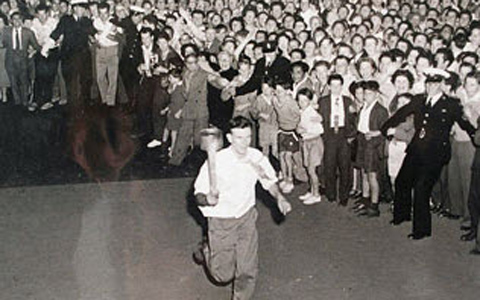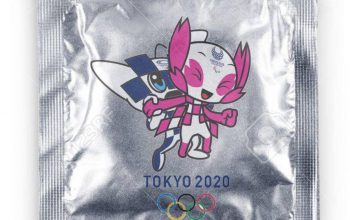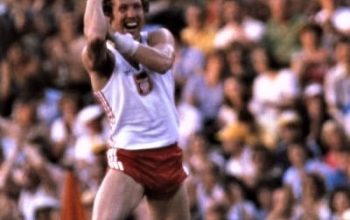On 9 January 2018, 82 year-old Barry Larkin returned to the scene of the crime, when he visited Sydney to be filmed by German/French public channel Arte for a documentary on Australia, which will be shown in May. Harry Blutstein, author of Cold War Games, was also in Sydney to participate in the documentary.
Barry Larkin had been part of a university prank, played on the mayor of Sydney, when he arrived before the official Olympic torch, and presented a fake one to the mayor, Pat Hills.
After the flame had been lit at Olympia in Greece, it made its way to Australia for the Olympic Games, a distance of over 14,000 km.
The Australian organisers decided to have a torch relay in which anyone over 15 could participate. The course was along the east coast of Australia from Cairns to Melbourne, taking in the three most populous major cities, as well as many country towns. While the Games were being held in Melbourne, the relay was one way to involve many Australians, and cement the reputation of the 1956 Olympics as the “friendly games”. Even Sydney, which had a strong rivalry and antagonism towards Melbourne, fell in and contributed to making the 1956 Olympics a success.
Once the torch was in Australia over 3,000 torchbearers we used, each running a mile of the route.
To qualify, they had to run the distance in under seven minutes in northern Queensland, where it was hot, to six minutes down south where it was cooler.
The flame arrived in Cairns during a thunderstorm at 1:40 pm on 9 November 1956, where it began its 4,200 km journey to Melbourne.
Each town along the way had competitions for local athletes to see which could qualify as a torchbearer. Australians enjoy a bet, and in Ingham when runners turned up at the local horse-racing track, bookmakers took bets on who would qualify.
In training for the torch run, athletes would use various tricks to get the feel of running with the top-heavy torch. One ran the full bottle of milk held up to get the feel of running with the torch. Another took a broomstick and tied it can fruit on top.
Each runner wore a white singlet and shorts and white running shoes. No women were allowed to join the relay or professional athletes. However, in Northern Queensland, a few women did get to run with the torch.
The first torchbearer was, appropriately, an Australian Greek called Con Verevis, and he was followed by Anthony Mark, a full blood aboriginal from Cape York. He ran barefoot, and it took him nine minutes to cover the mile—not because he was naturally slow but he thoroughly enjoyed the adulation of spectators and stopped to shake hands.
Torchbearers ran day and night, with crowds greeting them along the way. Even in the middle of the night they found farmers and their kids, in their pajamas, waving at them from the farm gate. Runners faced all sorts of difficulties, from potholed unmade roads, which were particularly dangerous at night with no lighting on country roads, snakes basking on the road during the day and kangaroos hoping across roads at dusk. Even through some faced dust storms and thunderstorms, had to ford rivers whose bridge had been washed away, it was run with military precision, and arrived in Sydney on schedule.
Many secondary students wanted to join in, but had to navigate around their final exams. In some cases, after finishing the exam in the morning they ran in the afternoon.
The torch was due to arrive at 7:32 PM in Sydney. Cross-country champion Harry Dillon was scheduled to bear the flame into Sydney, where he would present it to the mayor, Pat Hills. After making a short speech, Hills would pass the flame along to another runner, Bert Button.
As the mayor was getting ready, putting on his mayoral vestments and chain, he was alerted to the fact that the torch had arrived early. Half-dressed he rushed out to greet the torchbearer. Instead of finding cross-country champion Harry Dillon, who was supposed to deliver the torch, he found a young man wearing grey slacks, white shirt and a green tie slightly askew, and perspiring heavily. He accepted the torch and started on his speech, when Marcus Marsden, the organiser of the torch relay, stopped him and said: “that’s not the real torch.” It looked nothing like the official torch. It was a table leg and nailed with an old plum pudding tin nailed on top, and then painted with silver paint, which was still wet when it was handed to the mayor. In the tin were three pairs of underpants, which were ignited by a litre of kerosene, giving off a dull greasy flame.
Recovering quickly, the mayor announced to the spectators “That was a trial run. Our friends from the university think things like this are funny. It was a hoax by somebody. I hope you are enjoying the joke.” He then went back into the town hall to finish getting dressed. Ten minutes later the real Olympic torch arrived, carried by Harry Dillon.
The hoax was carried out by a young university student, Barry Larkin. After handing the torch to the mayor, Barry melted into the crowd and quickly hopped onto a tram which took into Newtown. In a local pub, he caught up with his friends, and they all enjoyed watching the whole episode on TV. That night Barry did not have to pay for his drinks.
Barry Larkin was never meant to take the torch. One of the other students, dressed in white shorts and T-shirt was ready to perform the hoax, but he got cold feet at the last minute. So someone handed Barry the torch and told him to get moving. He was accompanied by friend on a motorbike, who spectators mistaken for an official escort. By the time they reached the crowds the police took over and cleared a path for Barry to the Town Hall.
While the hoax was great fun for the students, it also had a real point to it. This Olympic torch relay had been invented for the 1936 Olympic Games in Berlin by the Nazis, who used it to show the connection between the glory of the Greek empire and the Third Reich.



